Automated simulation of scroll compressors
Reducing development times – through clever automation
Efficiency in the development process means, on the one hand, minimal time spent on design. On the other hand, it is about exploiting the full range of possibilities - both known and previously hidden. What this can mean specifically for engineering practice is shown by an example in which the technology service provider OBRIST Engineering and the simulation specialist CADFEM have combined their digital engineering expertise. The result is an engineering workflow for scroll compressors in which time-consuming processes and compromises that previously had to be accepted are now a thing of the past thanks to automation.
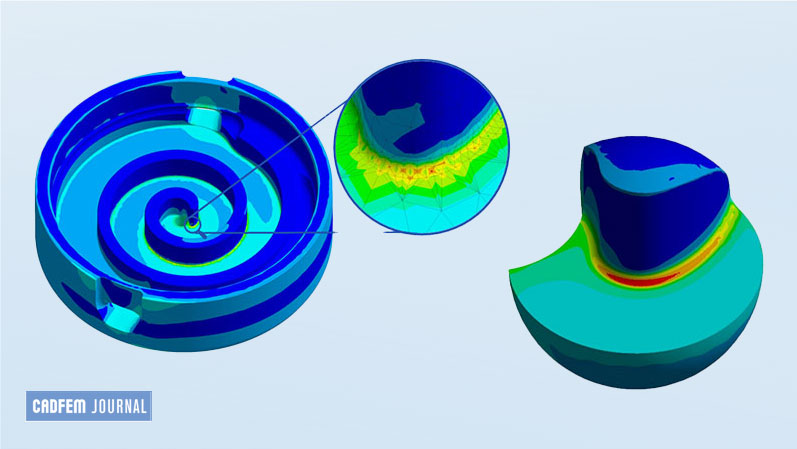
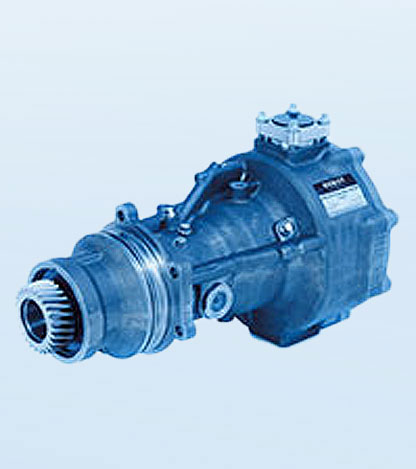
OBRIST Engineering, an Austrian technology company with around 40 employees, has been a leader in the development of automotive powertrain systems, thermal management, and waste heat recovery for over 25 years. One focus is on scroll compressors, which are mainly used in automobile air conditioning systems. Their main advantages compared to other compressor machines are high efficiency while maintaining very low noise levels. Scroll compressors are therefore particularly suitable for electric cars.
The basic principle of the scroll compressor is based on two spiral elements that are nested together. One element is fixed in position, the other moves in eccentric paths, with multiple points of contact between the spirals. This creates a positive displacement machine with multiple rotating chambers that become smaller with each revolution. The process gas drawn in, such as chemical (R1234yf) or natural (R744, R290) refrigerants as well as other gases for further applications, is highly compressed in the spiral channels from 100 mbar to 100 bar, depending on the application, and expelled in the center of the spirals. In this process, the scroll compressors from OBRIST Engineering operate at 500 to 11,000 revolutions per minute and the volume to be compressed is 4 to 200 cubic centimeters per revolution.
Mechanical and thermal loads
Compressors only remain competitive if they are continuously improved. One of the ways to optimize efficiency and analyze the effects of the compression process on individual components is to take a close look at the mechanical load. Added to this is the thermal load due to self-heating, whereby the resulting gas temperature or pressure varies greatly both locally in the compression chamber and over time depending on the angle of rotation. In order to be able to optimize the component design, it is important that these loads and the resulting deformations and stresses of the components involved in the compression process are known in advanced, and with a high degree of accuracy.
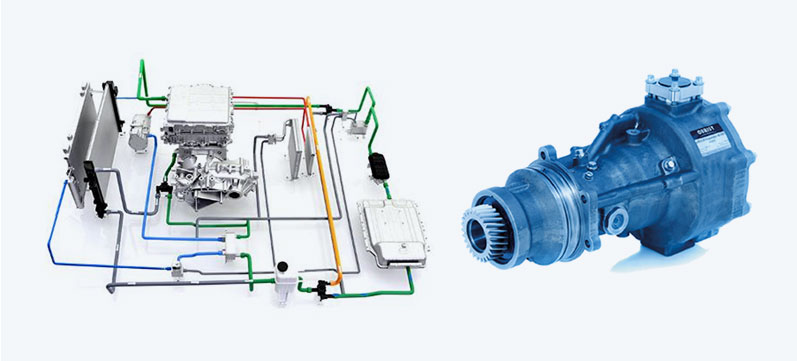
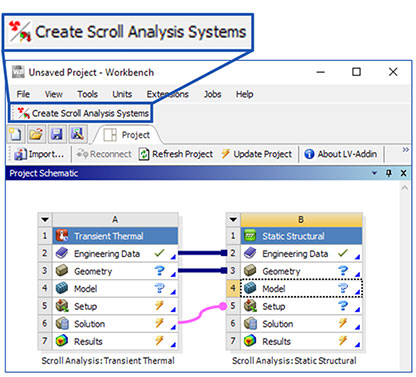
Ever better through automated simulation
Simulations always show their full potential when measurements on the test stand are particularly time-consuming or when processes are very complex. Both were true in this case. At first, an attempt was made to set up the simulation process manually. However, this approach did not deliver the desired quality of results or the speed required in a streamlined development process. Therefore, CADFEM was brought on board to jointly automate the simulation process for the scroll compressors. With the Ansys Application Customization Toolkit (ACT), the time-consuming manual pre- and post-processing work could be reduced to a minimum while also analyzing the effects of the compression process on individual components in much greater detail and at almost any resolution.
ACT in Action
For the automated simulation process, a thermal-mechanical analysis environment was created based on a 1-way coupling using the corresponding boundary conditions and solver settings. First, the thermal problem is solved, and the resulting temperature field is automatically transferred to the mechanical analysis in the background and mapped onto the components. An advantage of this approach is the possibility to use different meshing methods depending on the physics. For example, linear elements can be used for the thermal calculation and quadratic elements for the mechanical calculation.
Alejandro Catalá-Ruiz, computational engineer at OBRIST Engineering, explains, “for years, we had no solution available with which we could analyze the real stresses and deformations under pressure and temperature loads. This was because it was too time-consuming to define the loads manually and, in addition, the results were not accurate enough. The new automation solution with ACT allows a 1-way coupling based on a relatively simple simulation model, with which a complete calculation can be completed in one day. The otherwise required transient analysis with fluid-structure interaction would take several times as long.”
Alejandro Catalá-Ruiz (Computational Engineer at OBRIST Engineering)ACT offers great opportunities to implement user-specific automations. Both large amounts of data and complex processes can be easily handled.
Automated settings in the background
In order to bring the compressor components to the correct temperature level, the thermal load, which is repeated periodically once per revolution, is calculated several times in succession until a steady-state periodic temperature distribution is achieved. The time and location-dependent loads of a complete revolution of the compression process are calculated, exported, and read into the ACT automation solution using a program developed by OBRIST. They form the basis for the background definition of the application-specific framework conditions for the respective compressor variant as well as the control of the required load steps and solver settings for the calculations.
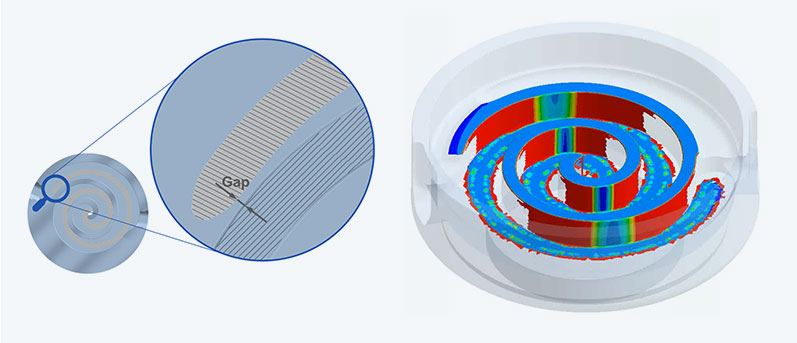
Gap widths that occur between the two spiral elements of scroll compressors during operation play a major role in the efficiency of the machine as well as the life cycle of the components. A gap that is too small leads to early wear, while a gap that is too large reduces efficiency due to leakage in the compression chamber. During the simulation, contact elements are positioned on the pressurized surfaces for gap detection.
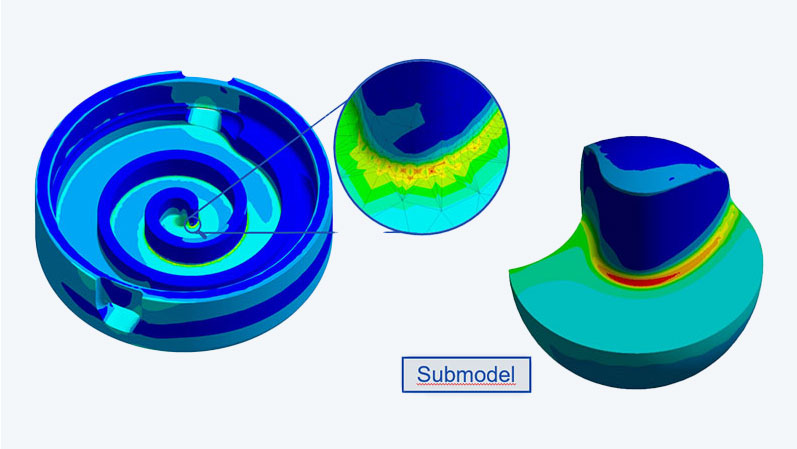
In order to determine the fatigue strength of the scroll compressor in as much detail as possible, the stress states of the components must be analyzed in detail. This requires very fine meshing, which in turn leads to long computation times. This challenge can be easily tackled using the sub-modeling function of Ansys. It makes it possible for only the areas of highest load to be finely meshed in order to specifically check whether the load limits are locally exceeded.
A deeper and more comprehensive insight
Alejandro Catalá-Ruiz summarizes, “with the new automated simulation solution, we can achieve higher product quality by improving functionality as well as making the operation more efficient and the design more robust. The simulations with the ACT solution enabled us to better understand the behavior of our scroll compressors. We have gained a deeper and more comprehensive insight into the real-world situations our compressors are exposed to. Since we started using the tool - through targeted testing - we have been able to confirm the simulation results. We could not have built up the know-how we have today about the real operating conditions of our scroll compressors with tests on prototypes alone.” With this workflow, OBRIST Engineering, as well as its customers, ensures a technological edge as a development service provider that is based on simulation.

OBRIST Engineering GmbH
www.obrist.at
Author: Gerhard Friederici
(CADFEM Germany GmbH)
Cover Images:
Right:© OBRIST Engineering GmbH
Left: © OBRIST Engineering GmbH
Published: September, 2023
Contact CADFEM




